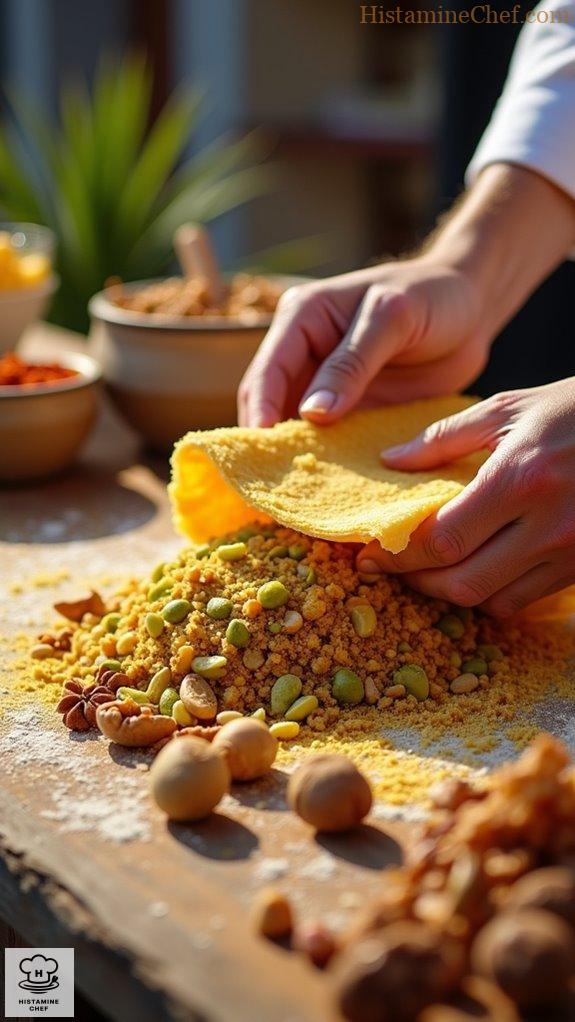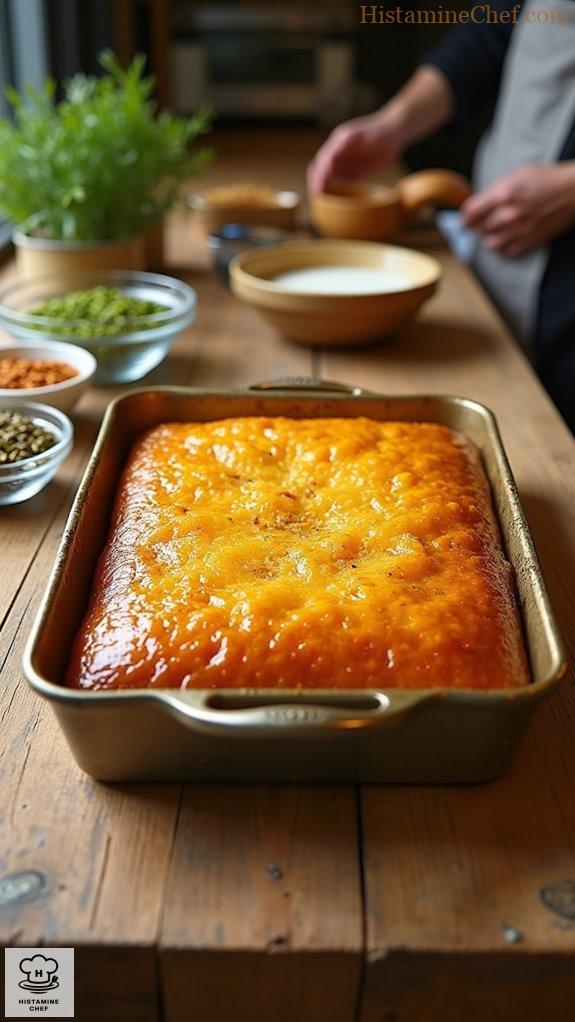If you’re itching for a taste of Iranian baghlava but need to keep histamines at bay, I’ve got a delicious hack for you! Start with thin phyllo pastry and layer it with layers of allowed nuts like almonds and pistachios, swapping ghee for coconut oil. Sweeten your creation with honey, and pour a warm syrup made of sugar and water over the golden pastry. Who knew making something so delectable could be so simple? Stick around to discover the art of perfecting this treat!
Historic Bazaars of Tehran

In the bustling heart of the Tehran Grand Bazaar, street food culture offers a tantalizing glimpse into the culinary traditions of Iran. This vibrant market has long been a melting pot for merchants and locals, creating a dynamic environment where food and commerce intertwine. The bazaar’s architecture, showcasing Persian architecture, adds to the ambiance, making it a perfect backdrop for enjoying various delicacies.
Historic street food vendors serve a variety of dishes, from kebabs to fresh herbs, nuts, and sweets, allowing visitors to savor authentic flavors. The history of cooking street food in this setting dates back to the bazaar’s inception during the Safavid era, where merchants would sell ready-to-eat meals to hungry travelers and shoppers, making the bazaar not just a commercial hub but also a social gathering point.
Over the centuries, street food has maintained its place in Iranian culture, reflecting regional ingredients and seasonal produce. Items like “samosas,” “kebabs,” and sweet delights such as “baghlava” have adorned the bazaar’s lanes, drawing in crowds with their enticing aromas.
This rich tradition continues today, with modern food stalls and eateries embracing both classic recipes and innovative twists, ensuring that the street food scene remains an integral part of the Tehran Grand Bazaar experience.
Freshly Folded by Street Vendors

Street vendors prepare Iranian baghlava by carefully hand-folding fresh filo dough into multiple layers interspersed with a mixture of finely chopped high-quality nuts, typically walnuts, almonds, and pistachios, combined with sugar and warm spices like cardamom and cinnamon.
The dough is coated with ghee or clarified butter to guarantee flaky texture, and each batch is baked in moderate temperatures until golden brown. Once out of the oven, hot syrup made from sugar, water, and lemon juice is drizzled over the warm pastry to allow it to soak for several hours, enhancing the flavor while maintaining crispness.
Vendors cut the baghlava into traditional diamond shapes to ease serving, and garnish it with chopped pistachios or rose petals for added appeal. The entire process is conducted on-site to ensure freshness and authenticity, making the experience culturally significant for customers.
Ingredients Needed:
- 500g filo dough sheets
- 300g mixed nuts (walnuts, almonds, pistachios)
- 200g granulated sugar
- 1 tsp ground cinnamon
- 1 tsp ground cardamom
- 250g ghee or clarified butter
- 200ml water
- 100ml lemon juice
Cooking Steps:
- Thaw and prepare filo dough sheets.
- Finely chop mixed nuts and spice mixture.
- Brush a layer of ghee onto a baking tray.
- Fold sheets with nuts and spice mixture.
- Layer and brush ghee between each sheet.
- Bake at moderate temperature until golden brown.
- Prepare hot syrup with sugar, water, and lemon juice.
- Drizzle syrup over baked baghlava immediately.
Homemade Low Histamine Baghlava

To prepare homemade low histamine Baghlava, start by substituting traditional ingredients for low histamine alternatives.
Use thin phyllo pastry layered with melted butter or coconut oil instead of ghee, and fill it with a mixture of finely chopped permitted nuts, such as almonds and pistachios, instead of walnuts or cashews.
Sweeten the filling using sugar or honey rather than maple syrup. For flavor, incorporate a hint of cinnamon and use a low histamine sweet syrup made from water, sugar, and optionally, a little agave.
Bake until golden brown and drizzle the syrup over the warm Baghlava for a perfect finish.
Ingredient Changes for Homemade Low Histamine Baghlava:
- Use phyllo pastry instead of traditional dough
- Substitute ghee with coconut oil
- Fill with allowed nuts (almonds/pistachios)
- Sweeten with sugar or honey
- Add a hint of cinnamon
- Prepare sweet syrup with sugar and water
- Avoid walnuts and cashews entirely
Low Histamine Variation of Baghlava

Histamine intolerance can notably limit a person’s diet, particularly when it comes to street food, which often contains high-histamine ingredients.
Many street foods are processed, fermented, or include liberators that can trigger symptoms for those affected. Eating outside can make it challenging to find suitable options.
Consuming street food like Iranian baghlava poses challenges for those with histamine intolerance. Traditional recipes may include restricted ingredients such as nuts and sweeteners that can provoke reactions.
According to the SIGHI list, walnuts and cashews are high-histamine, while certain sweeteners are also restricted. Consequently, it’s essential to be cautious and aware of these ingredients when considering street food options.
Low Histamine Variation of Baghlava Cooking Instructions:
- Replace nuts with allowed seeds like hemp or pumpkin seeds.
- Use permitted sweeteners like agave or maple syrup instead of traditional sugar.
- Substitute clarified butter for regular butter to avoid restriction.
- Ascertain all flour used is freshly ground to limit histamine build-up.
- Avoid adding spices like cinnamon, which is restricted; opt for safe alternatives.
- Use small amounts of distilled white vinegar to replace lemon juice.
- Eliminate any fermented components that may be present in traditional recipes.
- Bake at lower temperatures to minimize the risk of histamine formation.
- Prepare and consume the dish fresh rather than storing it to avoid increases in histamine levels.
- Serve with peppermint tea or water instead of any restricted beverages.
Video Summary
Baghlava is a traditional Persian dessert beloved for its rich flavors and complex layers. In this video, we’ll explore both the street-style and a low histamine home version of baghlava.
Street vendors make this classic treat by layering thin sheets of pastry known as phyllo dough. They brush each layer with melted butter using a pastry brush. Chopped nuts, usually pistachios and walnuts, are sprinkled generously between the layers. They then cut the layered pastry into diamond shapes before baking in a large pan. Once golden brown, they remove it from the oven to cool. A sweet syrup made with sugar and water is poured over the hot baghlava, soaking into every layer. This gives it its signature sweetness and sticky texture.
For the low histamine version, we make some changes. First, instead of butter, use coconut oil to brush the pastry. Replace walnuts with almond nuts since they’re allowed. You still sprinkle the chopped nuts between the layers as usual.
Adjust the syrup by using honey instead of sugar. Avoid any flavorings that may trigger sensitivities like citrus. When baking, keep an eye on the baghlava until it turns lightly golden, as it can vary.
After cooling, drizzle honey syrup over the top. This version retains the sweet and nutty essence while being more suitable for sensitive individuals. The final dish still looks inviting, with golden layers and a nutty topping.
Click the link in the description for the full recipe!
References
- https://iranamaze.com/tehran-bazaar/
- http://www.eavartravel.com/blog/2023/10/20/130716/tehran-grand-bazaar/
- https://www.irannegintravel.com/iran-highlight/tehran-grand-bazaar
- https://www.tripadvisor.com/Attraction_Review-g293999-d485291-Reviews-Tehran_Grand_Bazaar-Tehran_Tehran_Province.html
- https://en.wikipedia.org/wiki/Grand_Bazaar
- https://faestwistandtango.wordpress.com/2013/03/20/baklava-iranian-style-2/
- https://www.thedeliciouscrescent.com/baklava/
- https://food52.com/recipes/9184-persian-baklava
- https://persianmama.com/baklava-baghlava/
- http://www.cafeleilee.com/2014/12/cooked-fava-beans.html


Leave a Reply